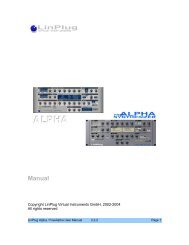CrX4 User Manual - LinPlug Virtual Instruments
CrX4 User Manual - LinPlug Virtual Instruments
CrX4 User Manual - LinPlug Virtual Instruments
Create successful ePaper yourself
Turn your PDF publications into a flip-book with our unique Google optimized e-Paper software.
Next is the Sample Name display, which not only indicates the name of the<br />
used sample, but also has a color coding: When written in white, the<br />
sample is from the <strong>CrX4</strong> library (within the Library folder), when it is dark<br />
red it is from outside the Library (thus indicating you need to make sure it is<br />
always available at its current location as <strong>CrX4</strong> might else not be able to<br />
relocate it). A light red written sample name indicates that the sample could<br />
not be located. As a guideline it is a good idea to save all presets to the “My<br />
Presets” folder (or another user created folder) within the Library, as this<br />
makes sure your samples are all in the Library and all you need to backup<br />
is the Library (and no other locations).<br />
The Sample control is used for loading and unloading samples. The Load<br />
button (folder symbol) opens a dialog that lets you select a file for loading.<br />
The Previous and Next buttons allow you to traverse a list of samples. The<br />
Clear button (X symbol) is used to remove a sample from the Generator<br />
(thus freeing memory and producing no sound anymore).<br />
The Range controls is used to set the relative start and end point of the<br />
sample. If the first (upper) value is set to 0 the sample starts right from the<br />
file’s original start point. Higher values set the start point towards the end of<br />
the sample. The same applies to the second (lower) value adjusting the<br />
end of the used region of the sample.<br />
The Root control enables you to set the unity note of the loaded sample. If,<br />
for example, you set Root to C1 and play a C2 the sample will be played<br />
one octave above its original frequency. In the case of the Time Sampler<br />
Generator, if you wish to obtain the most natural sound then it's essential<br />
that the sample's root note is set to the same note as the one at which the<br />
sample was initially recorded. Otherwise the Generator will produce<br />
unusual effects. In many cases however, it is precisely these effects that<br />
give the CronoX its interesting and unique sounds.<br />
The Loop switch enables a complete loop of the sample, that is, when it<br />
comes to its end it starts from the begin again. This is aprticular useful with<br />
short samples of when you shorten its time with the Time parameter.<br />
<strong>CrX4</strong> <strong>User</strong> <strong>Manual</strong> 16












